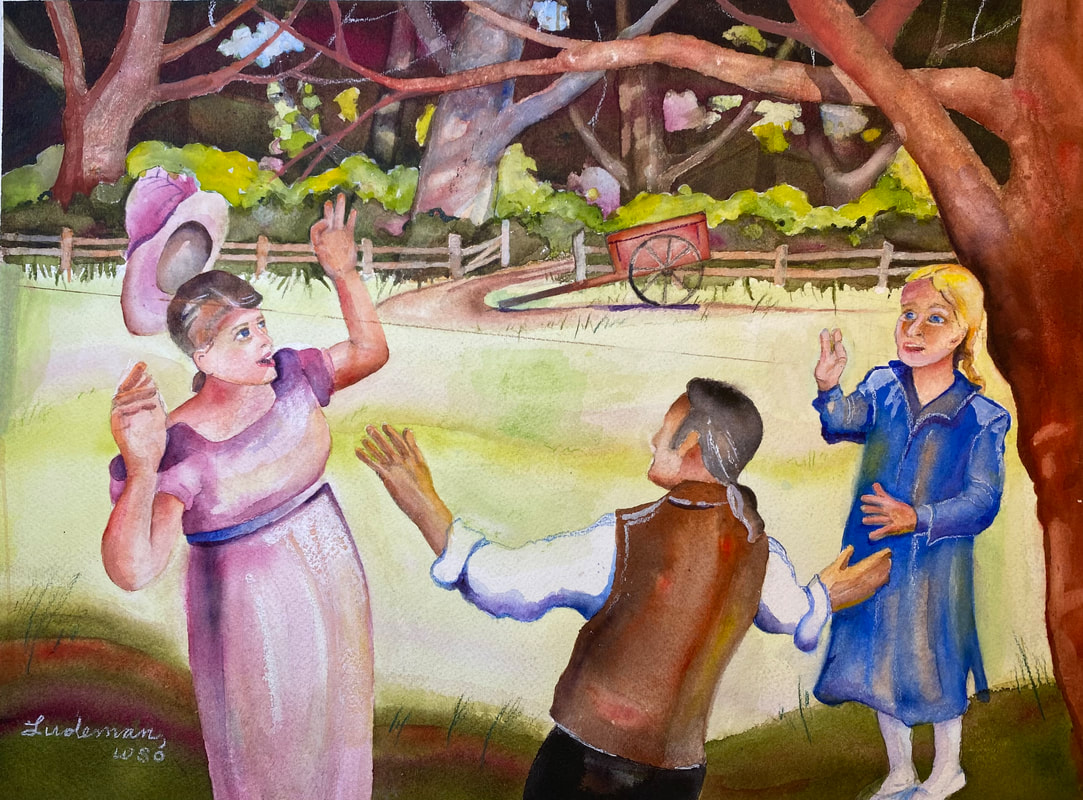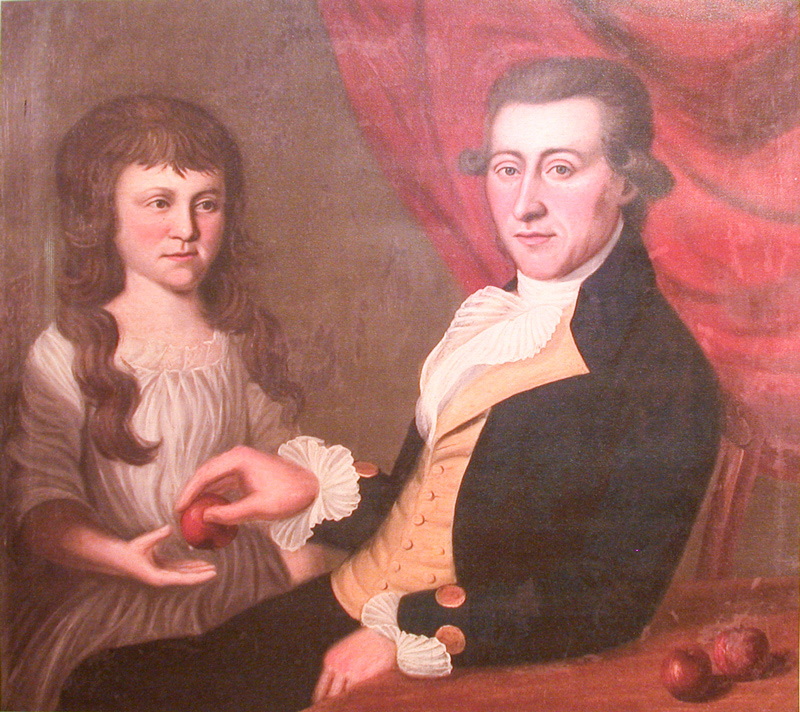Misfire
Watercolor by Steve Ludeman
© 2023 by Steve Ludeman, www.steveludemanfineart.com. Used by permission.
When Captain Lewis and his crew landed on Brunot’s Island, the residents asked him to demonstrate his air rifle. He fired at a target seven times with good accuracy. Then, Mr. Blaise Cenas asked to see the rifle. While holding it, Mr. Cenas accidentally discharged it—the exact moment shown above.—Steve Ludeman
Meriwether Lewis arrived in Pittsburgh early in the afternoon of 15 July 1803, expecting the 55-foot military barge (called the ‘boat’ or ‘barge’ but never the ‘keelboat’) he had contracted for would be finished in less than three weeks. Day after frustrating day, through a crescendo of shameful delays and “unpardonable negligence” on the builder’s part, work was completed at 7:00 a.m. on 31 August 1803–five weeks late.[1]He recounted his frustrations in a letter to Thomas Jefferson, from Wheeling on 8 September 1803. Donald Jackson, Letters of the Lewis and Clark Expedition with Related Documents 1783-1854 (Urbana … Continue reading Hastily loading a small portion of his cargo–some was loaded into a smaller boat he called a pirogue, and more was shipped to Wheeling, West Virginia, by wagon–Lewis weighed anchor shortly before noon, and without fanfare set out down the Ohio River. His crew consisted of eleven hands, including seven soldiers plus a man named Moore whom he had hired to pilot the boat as far as the Falls of the Ohio at Louisville. Also, there were “three young men on trial,” possibly including George Shannon and John Colter.
About five miles below the dock Lewis went ashore for “a few minutes” on Brunot’s Island, perhaps to exchange a few parting words, and to accept wishes for a bon voyage, from some fellow Freemasons he had met during his six-week residence in Pittsburgh.[2]Lewis was elected to membership in the Door to Virtue Lodge of the Order of Freemasons on January 28, 1797, and within three months rose through the consecutive Degrees until he attained the status … Continue reading Those acquaintances included 27-year-old Blaise Cenas, nephew-in-law of the island’s owner, Dr. Felix Brunot, a French surgeon with a practice in Pittsburgh. Other local Masons who might also have been on the island at that time included Isaac Craig, John Fowler, Henry Baldwin, and two of Lewis’s old friends, Hilary Baker, and the Pittsburgh businessman Tarleton Bates. One or more women were present too, including Cenas’s wife, and other relatives of Dr. Brunot, perhaps including a few children.
An Accidental Shooting
Close Call
Watercolor by Steve Ludeman
© 2023 by Steve Ludeman, www.steveludemanfineart.com. Used by permission.
Forty yards away, the rifle ball grazed a woman’s temple, knocking off her hat. She fell immediately and was unconscious. All were concerned she was seriously injured or dead; but fortunately, the wound was only superficial. Captain Lewis administered first aid and she revived quickly. He resolved not to let anyone else hold his air rifle again!—Steve Ludeman
Dr. Felix Brunot and Ann Elizabeth Brunot
by Charles Willson Peale, Philadelphia c. 1789
Senator John Heinz Pittsburgh Regional History Center.
Betsy may have been among the women on the island when Lewis stopped by in 1803; she would have been about 21 years of age.
Whoever was on the island, at least someone among them must have known Lewis would stop by, and that he had with him an air gun[3]Lewis’s weapon is consistently referred to throughout the journals as a gun, never as a rifle. that he had “recently purchased,” for when he arrived they asked him to demonstrate it. Perhaps they even set up the firing range in advance and erected a suitable target.[4]The author is indebted to William K. Brunot, a descendant of Dr. Felix Brunot, for the foregoing summary, and for other details as hereafter noted. Felix Brunot (1752–1838) came to America with his … Continue reading But none of them could have anticipated that Lewis’s brief visit would culminate in an incident which would come within a few hundredths of an inch of inflicting death upon a bystander, and could have cast a pall upon the forthcoming Expedition. Lewis carried the air gun ashore, and while friends and crew looked on:
charged it and fired myself seven times fifty five yards with pretty good success; after which a Mr. Blaze Cenas being unacquainted with the management of the gun suffered her to discharge herself accedentaly the ball passed through the hat of a woman about 40 yards distanc cutting her temple about the fourth of the diameter of the ball; shee feel [fell] instantly and the blood gusing [gushing] from her temple we were all in the greatest consternation supposed she was dead by [but] in a minute she revived to our enespressable satisfaction, and by examination we found the wound by no means mortal or even dangerous; called the hands aboard and proceeded.
Unanswered Questions
Lewis’s terse summary of the incident leaves many questions unanswered. The very presence in his baggage of so unusual a weapon makes us wish to know more about it. Why did he acquire it, from whom, and where? Did he buy it or borrow it? Who made it, where, and when? What was the caliber, and how did the gun operate? Was it a smooth-bore gun, or was the barrel rifled (grooved)? How powerful was it, in terms of effective air pressure and muzzle velocity? At present, one can do no more than speculate upon any of the answers. And who was the injured woman? No one knows for sure.
Above all, how could this accident possibly have happened? Consider the relative odds. For two years, four months and ten days from the time the expedition officially began, 31 men each carried and used at least one firearm. Hunters were out, singly and in groups, almost every day, often under extreme conditions in unfamiliar country. There were a few close calls, but only one injury.[5]On 11 August 1806 Captain Lewis and Private Pierre Cruzatte “took different routs through & thick willows in pursuit of an elk” on an island, and the one-eyed, myopic Cruzatte mistook … Continue reading By comparison, the odds were far greater against the accident on Brunot’s Island.
To begin with, it is unreasonable to assume that the unfortunate Blaise Cenas was deliberately aiming toward anyone, and especially toward a woman 40 yards–perhaps 50 steps–away, who surely would have placed herself safely out of the line of fire between Lewis and the target. Furthermore, considering the purpose and brevity of the gathering, there would have been relatively few opportunities for an accidental discharge of the weapon. But anyway, it happened.[6]William Brunot, personal communication. Nicholas Biddle, in his 1814 paraphrase of Lewis and Clark’s journals, included four journal references to exhibitions of the air gun for Indian audiences, but evidently saw no reason to ask Clark for details about it during their visits in April 1810, and so provided no additional information. He did not mention the accident because it occurred before the official commencement of the expedition on 14 May 1804. The accident first came to light when Milo Quaife published his edition of Lewis’s Eastern Journal in 1916.[7]Milo Milton Quaife, ed., The Journals of Captain Meriwether Lewis and Sergeant John Ordway Kept on the expedition of Western Exploration, 1803 -1806 (Madison: State Historical Society of Wisconsin, … Continue reading Serious interest in the weapon among gun historians apparently began with the work of Charter Harrison about 1956, and increased during the second half of the 20th century until, with the approach of the bicentennial observance, the enigma of Lewis’s air gun became one of the major points of contention among serious students of the expedition.[8]See Lewis’s Air Gun on this site.
Notes
| ↑1 | He recounted his frustrations in a letter to Thomas Jefferson, from Wheeling on 8 September 1803. Donald Jackson, Letters of the Lewis and Clark Expedition with Related Documents 1783-1854 (Urbana and Chicago: University of Illinois Press, 1978), Vol. 1:121-22. |
|---|---|
| ↑2 | Lewis was elected to membership in the Door to Virtue Lodge of the Order of Freemasons on January 28, 1797, and within three months rose through the consecutive Degrees until he attained the status of Past Master Mason. Two years later he advanced to the level of Royal Arch Mason in Widow’s Son Lodge at Milton, Virginia, a village situated about thirty miles down the James River from Richmond. During the expedition he named three tributaries of “Jefferson’s River” for three of the virtues celebrated in Masonic ritual, Philosophy (now Willow Creek), Wisdom (now Big Hole river), and Philanthropy (now Ruby river). The brief soliloquy he wrote in his journal on his thirty-first birthday, which he observed while among the Lemhi Shoshones on 18 August 1805, resonated with the tone of the Masonic ritual he knew so well. In 1808, he helped to establish the first Masonic lodge in St. Louis, served as its first Worshipful Master, and sponsored William Clark‘s membership in the order. See Eldon G. Chuinard, “Lewis and Clark–Master Masons,” We Proceeded On, Vol. 15, No. 1 (February, 1989); Jerome O. Steffen, William Clark: Jeffersonian Man on the Frontier (Norman: University of Oklahoma Press, 1977), 156. |
| ↑3 | Lewis’s weapon is consistently referred to throughout the journals as a gun, never as a rifle. |
| ↑4 | The author is indebted to William K. Brunot, a descendant of Dr. Felix Brunot, for the foregoing summary, and for other details as hereafter noted. Felix Brunot (1752–1838) came to America with his foster brother, the Marquis de Lafayette, and served on the medical staff of Lafayette’s expeditionary force. He moved to Pittsburgh in 1797, and in 1800 purchased the island, once known as Chartier’s or Hamilton Island. Dr. Brunot was known for his experiments with the use of electricity in the treatment of certain illnesses. |
| ↑5 | On 11 August 1806 Captain Lewis and Private Pierre Cruzatte “took different routs through & thick willows in pursuit of an elk” on an island, and the one-eyed, myopic Cruzatte mistook the leather-clad Lewis for an animal and shot him in the buttocks. |
| ↑6 | William Brunot, personal communication. |
| ↑7 | Milo Milton Quaife, ed., The Journals of Captain Meriwether Lewis and Sergeant John Ordway Kept on the expedition of Western Exploration, 1803 -1806 (Madison: State Historical Society of Wisconsin, 1916). |
| ↑8 | See Lewis’s Air Gun on this site. |



